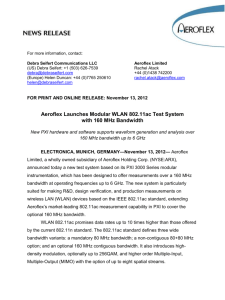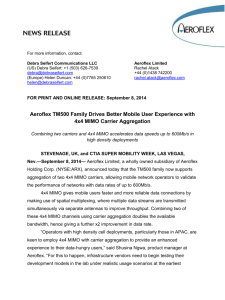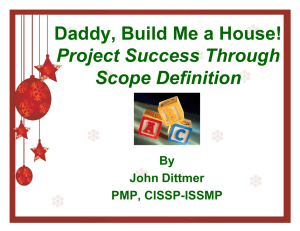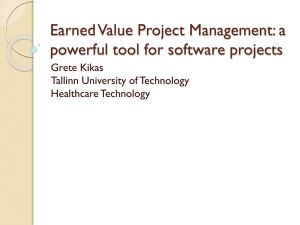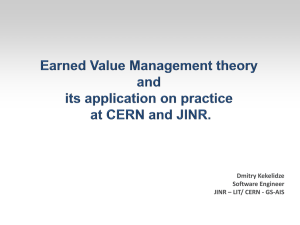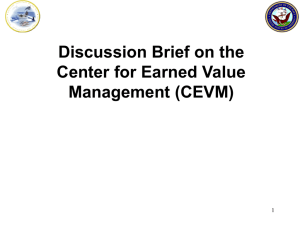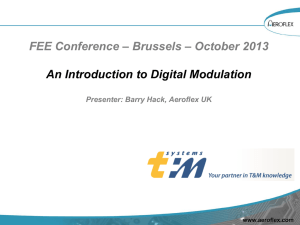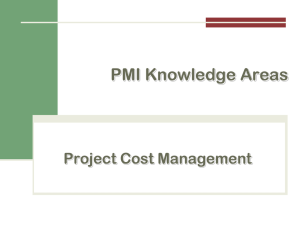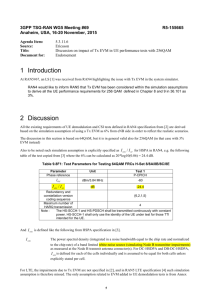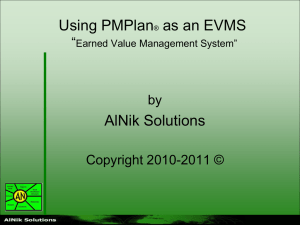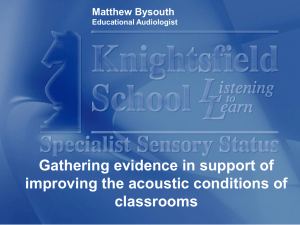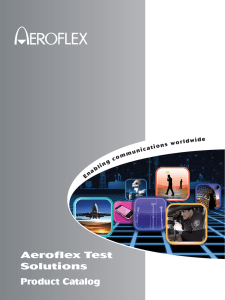7100 Roadmap - Microwave & RF
advertisement
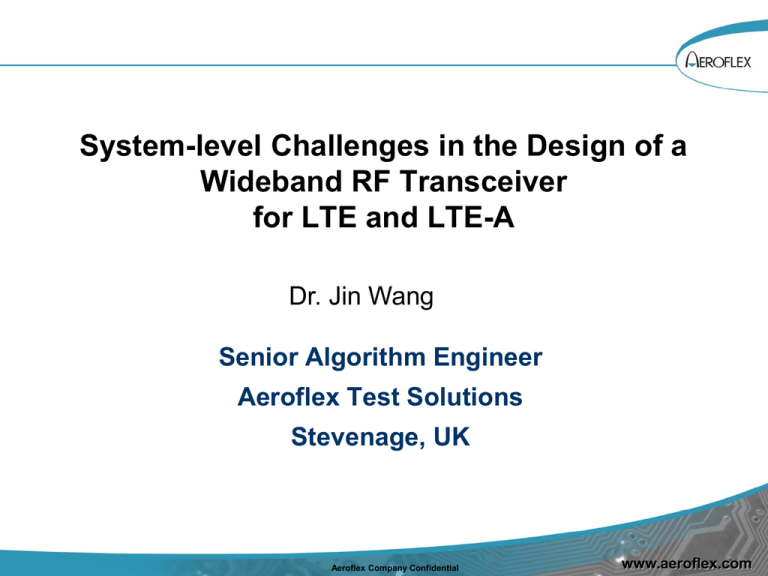
System-level Challenges in the Design of a Wideband RF Transceiver for LTE and LTE-A Dr. Jin Wang Senior Algorithm Engineer Aeroflex Test Solutions Stevenage, UK Aeroflex Company Confidential www.aeroflex.com Agenda ▼ 1. Design Objectives ▼ 2. Design Challenges ▼ 3. Summary ▼ 4. Q&A www.aeroflex.com 1.1 3GPP LTE Air Interface Overview Modulation DL: OFDM UL: DFTS-OFDM Signal Bandwidth 1.4,3,5,10,15,20 MHz Signal PAPR (Crest Factor) DL: ~11 dB, UL: ~8 dB FFT Size 2048 (Normal CP) Sub-Carrier Spacing 15 kHz (Normal CP) DL MIMO 2x2 (Rel-8) 4x4, 4x2 (Rel-9) UL MIMO 2x2 (Rel-9) Max Data Rate DL: 150~300 Mbps UL: 50~100 Mbps www.aeroflex.com 1.2 Product Overview: TM500 ▼ Industry Standard Base Station Tester for LTE and HSPA ▼ LTE Rel-8,9,10 and beyond ▼ From RF to Protocol Layers www.aeroflex.com 1.3 Wideband Radio Card ▼ ▼ ▼ ▼ Operating Frequencies: 400MHz~4GHz Signal Bandwidth: up to 20 MHz Transceiver Units: 2 RX, 1 TX Form Factor: double height and double width of a uTCA slot www.aeroflex.com 1.4 Translate System Req. to RF Req. System Engineers Receiver Sensitivity Noise Figure Maximum Throughput EVM Floor System Bandwidth Filter Spec. MIMO LO Phase Noise Hand-over LO Settling Time … Product Managers/End Users … RF Engineers www.aeroflex.com 2. RF Design Challenges ▼ Homodyne or Heterodyne? ▼ What’s the minimum requirement on Noise Figure? ▼ What’s the minimum requirement on EVM floor? ▼ The biggest blocker might be your own TX! ▼ Do we need to worry about IQ imbalance? ▼ What about phase noise? ▼ Further challenges in LTE-A www.aeroflex.com 2.1 Homodyne or Heterodyne? ▼ Homodyne (direct conversion/zero-IF) Pros: - fewer processing stages - No image frequency problem - Mainstream design in recent years Cons: - IQ imbalance - DC offset or carrier leakage www.aeroflex.com 2.2 Noise Figure < ? ▼ Max noise figure allowed depends on the RX sensitivity requirement, e.g. 3GPP requires that no less than 95% of maximum throughput is achieved on a reference measurement channel (BW=10MHz) when minimum input power of PREFSENS=-97dBm is applied (from 3GPP 36.101). 100 90 80 70 T-put (%) (I) SNRmin = -1 dB 60 50 40 30 20 10 0 -2 -1.8 -1.6 -1.4 -1.2 SNR (dB) -1 -0.8 -0.6 www.aeroflex.com 2.2 Noise Figure (Cont’d) PREFSENS SNR PN = Pthermal + NF NF NF<7 dB Pthermal = kTB (II) NF = PREFSENS – Pthermal – SNRmin www.aeroflex.com 2.3 EVM Floor <? E e2 rm s ErrorLevel EVM 2 Es rm s Signal Level SNR 20 Log(EVM) (dB) ▼ EVM results from various RF non-idealities: carrier leakage, IQ imbalance, gain compression, phase noise, frequency error, etc; ▼ Overall EVM floor limits the max achievable T-put! ▼ Given a EVM value, the error power increases linearly with the signal power; ▼ The effect on BLER/T-put may be treated as noise, hence EVM can be converted to SNR; www.aeroflex.com 2.3.1 EVM Floor, Noise Figure and SNR SNR clamped by the EVM floor. Noise Figure=7dB, EVM Floor=1.8% 50 40 1% 30 3% 1.8% 20 10% 10 32% 0 -10 -130 Noise limited EVM limited Combined -120 -110 -80 -90 -100 RSRP (dBm/sc) -70 -60 -50 EVM SNR (dB) SNR increases with the input signal power. LTE requires near 30 dB SNR to achieve the max T-put (150Mbps with 2 layers). Note: SNR is defined at the output of the RF front-end, i.e. baseband www.aeroflex.com 2.3.2 EVM Floor, Noise Figure and T-put Consider three RF front-end with different NF and EVM characteristics. No effect on T-put. EVM is the 50 differential 40 1% factor. NF is the differential factor. 30 3% 20 10% 10 32% 0 -10 -130 EVM SNR (dB) ▼ NF=4dB,EVM=1% NF=7dB,EVM=1.8% NF=7dB,EVM=3% -120 -110 -100 -90 -80 RSRP (dBm/sc) -70 -60 -50 www.aeroflex.com 2.4 TX Blocking TX Max Power: ~ 23 dBm Transmitter duplex Receiver RX REFSENS: ~ -97 dBm ▼ ▼ The TX power can be 120 dB higher than the RX power; The TX and RX frequency separation can be as small as 30 MHz; www.aeroflex.com 2.4 TX Blocking (Cont’d) Consequences: ▼ Particularly serious for wideband transceivers ▼ Cause compression in the RX amplifiers and demodulator ▼ Desensitize the receiver ▼ Limit the max TX power allowed Solutions: ▼ Application-specific: - Block-tolerant front-end; - TX Power back-off for lab operations; - Half-duplex mode for budget handsets; ▼ Advanced techniques: - Adaptive interference cancellation duplexer www.aeroflex.com 2.5 IQ Imbalance ε: Amplitude error θ: Phase error Wanted Signal xRF (t ) I (t ) cos(c t ) Q(t ) sin(c t ), x LPF (t ) cos( ) j sin( ) I (t ) jQ(t ) cos( ) j sin( ) I (t ) jQ(t ) x L (t ) x L* (t ) Image Signal www.aeroflex.com 2.5.1 Self-Interference induced by IQ Imbalance 140 X: 4.8 Y: 134.9 120 X: -4.8 Y: 93.87 Mag (dB) 100 SIR=41 dB 80 60 40 20 -80 -60 -40 -20 0 Freq (MHz) 20 40 60 80 Single tone measurement - Input: cos(2π(fc+fm)t) - Output Expected : cos(2πfmt)+j sin(2πfmt) www.aeroflex.com 2.5.2 SIR of IQ Imbalance 6 18 20 20 5 18 20 22 4 24 3 26 26 28 2 30 1 32 SIR 10log10 3 2 2 4 5 6 Amplitude Error (%) 7 8 20 2 22 1 26 30 0 24 28 36 34 40 38 0 20 24 22 Desired Region Phase Error (degree) 22 9 10 2 2 1 t an 10log10 2 t an2 www.aeroflex.com 2.6 LO Phase Noise f2 P L(f)df f1 rms 180 EVM 2 P (deg) rms 100% 180 Source: Analog Devices® ADF4350 datasheet Integrated Phase Noise Power (15KHz~10MHz): P = -44.1 (dBc) RMS Phase Error: θRMS = 0.50 (deg) EVM = 0.88% www.aeroflex.com 2.6.1 Phase Noise on OFDM Constellation CPE dominated ICI dominated Loop Bandwidth=10kHz Loop Bandwidth=40kHz 1.5 1.5 1 1 0.5 0.5 0 0 -0.5 -0.5 -1 -1 -1.5 -1.5 -1 ▼ ▼ ▼ -0.5 0 0.5 1 1.5 -1.5 -1.5 -1 -0.5 0 0.5 1 1.5 Two types of effects: - Common Phase Error (CPE) - Inter sub-Carrier Interference (ICI) CPE can be easily corrected, ICI not Loop BW ↓ lock time ↑ www.aeroflex.com 2.7 LTE-A: High Order MIMO Downlink: 8x8 - 8 RX processing chains – high density - L1 data rate 600 Mbps - ADC Sample data rate: 30.72MSamp/s x (2x16 bits/sample)x8 = 7.86 Gbps Uplink: 4x4 - 4 TX processing chains – high density - L1 data rate 300 Mbps - DAC sample data rate: 30.72MSamp/s x (2x16 bits/sample)x4 = 3.93 Gbps www.aeroflex.com 2.8 LTE-A: Carrier Aggregation Contiguous CA N*300kHz 20 MHz 20 MHz 20 MHz 20 MHz Band 4 Band 3 20 MHz Band 7 ~ 40 MHz Non-contiguous CA CC for operator-B N*100 kHz 20 MHz 5 MHz 10 MHz 15 MHz 10 MHz 20 MHz Band 3 Band 4 N*300 kHz Non-contiguous aggregated CC for operator-A Band 7 LTE-A allows up to 5 component carriers. Each component carrier can be 1.4, 3, 5, 10, 15 and 20 MHz. The maximum aggregated system bandwidth is 100 MHz. The three possible carrier aggregation types are: - Intra-band contiguous carrier aggregation - Intra-band non-contiguous carrier aggregation - Inter-band carrier aggregation www.aeroflex.com LTE-A in the News ▼ World-record 1.4 Gbps in LTE-Advanced demo (03/2012 source: http://4g-portal.com ) - 5 component carriers - 20MHz 4x4 MIMO each - and TM500! ▼ TM500 supports the development of multiband lightRadio® technology. www.aeroflex.com Summary ▼ Introduction to LTE and the Test Mobile: TM500; ▼ How to determine various RF system parameters such as: noise figure, EVM floor, TX leakage, IQ imbalance and phase noise; ▼ Further challenges from LTE-A: high order MIMO and CA; www.aeroflex.com
